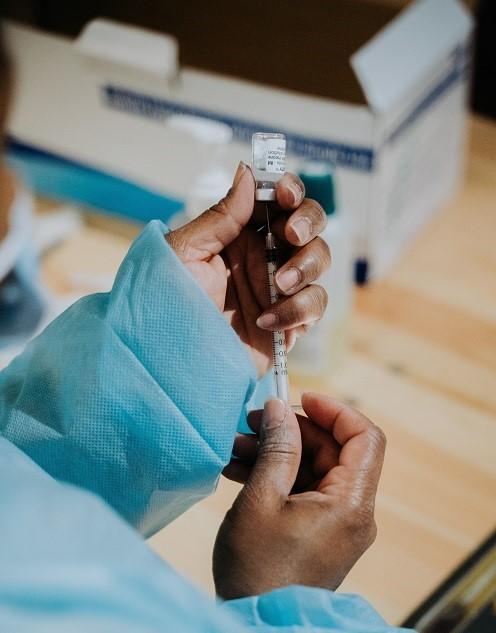Yesterday in the New England Journal of Medicine, two more studies confirmed high rates of vaccine effectiveness (VE), even against severe disease, and the vaccines' potential to prevent disease transmission.
The VE study used a test-negative design to look at COVID-19 vaccination in US adults 50 years and older, calculating a VE of 89% against COVID hospitalization, 90% against COVID-related intensive care unit (ICU) admission, and 91% against COVID-related emergency department (ED) or urgent care clinic (UCC) visits.
The second study suggested that, among Scottish households with a fully vaccinated healthcare worker, COVID infection risk dropped 54% for the other households members compared with households whose healthcare workers remained unvaccinated.
Vaccine effectiveness 89% and up
Researchers estimated the VE of the Pfizer/BioNTech, Moderna, and Johnson & Johnson vaccines across 41,552 hospitals and 21,522 visits to 221 ED or UCCs in 36 geographic subregions in the United States from Jan 1 to Jun 22. Patients were all 50 years or older and were seeking healthcare for COVID-like illness; the median patient ages for hospitalization or ED/UCC visits were 74 and 70 years, respectively.
Unvaccinated patients made up 49% of those who were hospitalized and 55% of those who visited an ED or UCC. Only 10% of hospital admissions and 15% of ED or UCC visits were connected with a positive COVID-19 test; the rest had COVID-like symptoms but tested negative.
Of those who were vaccinated, 53.4% of those hospitalized (whether COVID-positive or not) received Pfizer, 42.2% received Moderna, and 3.3% received Johnson & Johnson. Similar proportions were found in those who visited the ED or UCCs, with a highest difference of 1.7 percentage points.
VE after full vaccination with either mRNA vaccine was 89% against COVID hospitalization (95% confidence interval [CI], 87% to 91%), 90% against COVID-related ICU admission (95% CI, 85% to 93%), and 91% against COVID-related ED or urgent care clinic visits (95% CI, 89% to 93%).
VE ranged from 81% to 95% for those 85 or older, those with chronic medical conditions, and Black or Hispanic adults. The researchers find those results encouraging, as those populations have been more vulnerable during the pandemic.
The Johnson & Johnson vaccine had a 68% VE against COVID-19 resulting in hospitalization and 73% VE against COVID-19 illness leading to ED or UCC visits (95% CIs, 50% to 79% and 59% to 82%, respectively).
More test-negative studies to come
Test-negative have been used to assess VE for the seasonal flu vaccine for years, but as Natalie E. Dean, PhD, et al write in a related editorial, they have gained popularity for COVID-19 vaccinations (including a study, also published yesterday, that showed Pfizer and Moderna offered high protection against COVID infection).
Still, the editorial authors caution that researchers should keep in mind sample bias, misclassification of infection or vaccination status, and confounding variables. Because the main differentiator is the test result, they say, other factors relating to the likelihood of vaccine receipt or medically attended COVID-19 could influence results. Generalizability can also be questionable, but the authors note that severe medical outcomes, such as with this study led by Mark G. Thompson, PhD, are considered less sensitive.
"[Observational studies] are being used to generate evidence of effectiveness against outcomes that are underpowered in trials, such as hospitalization or intensive care unit (ICU) admission, or for narrow subgroups," they write. "Researchers who use test-negative designs to investigate Covid-19 vaccine effectiveness can look to the article by Thompson et al. for examples of how to report primary findings and assess the sensitivity of these findings to potential biases that are specific to the test-negative design."
Transmission risk lowers after vaccination
In the vaccine study on COVID-19 transmission, UK researchers looked at 144,525 Scottish healthcare workers who were working from March to November 2020 and their 194,362 household members.
As healthcare workers were some of the first to be offered COVID-19 vaccines (either Pfizer AstraZeneca/Oxford), the primary outcome was any confirmed COVID-19 infection from Dec 8, 2020, to Mar 3, 2021. The researchers excluded any COVID-19 events that occurred after another household member got vaccinated.
Fourteen days after the healthcare worker received a first COVID-19 vaccine dose, cases of COVID-19 among other household members dropped from 9.40 events per 100 person-years to 5.93. After the second dose, prevalence dropped further, to 2.98 events per 100 person-years, and the researchers say the differences remained after adjusting for calendar time, geographic region, age, sex, occupational and socioeconomic factors, and underlying health conditions.
Overall, the hazard ratio for COVID-19 in household members was 0.70 (95% CI, 0.63 to 0.78) 14 days after the first dose (a 30% risk reduction) and 0.46 (95% CI, 0.30 to 0.70) 14 days after the second dose (54% reduction), which is when the healthcare worker was considered fully vaccinated. Data also suggested that vaccination reduced the number of COVID-19 cases and hospitalizations in healthcare workers, as well.
"Not all the cases of COVID-19 in the household members were transmitted from the health care worker; therefore, the effect of vaccination may be larger," the researchers write. "For example, if half the cases in the household members were transmitted from the health care worker, a 60% decrease in cases transmitted from health care workers would need to occur to elicit the association we observed."
During the study, 78.4% of healthcare workers had received at least one dose, and 25.1% had received a second dose. Households ranged from 2 to 14 members, and more than 96% of study participants were White. The average age of healthcare workers and household members was 44 and 31 years, respectively.






















